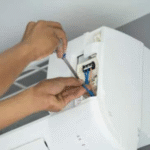There’s something quietly satisfying about a smooth, level slab of concrete. It doesn’t beg for attention. It doesn’t show off. But it carries the weight—literally—of driveways, patios, sidewalks, and garage floors across the country. Concrete flatwork, while it sounds like the kind of phrase you’d expect to hear on a contractor’s clipboard or during a zoning meeting, is actually a key part of our everyday lives. And if you’ve ever tripped over a cracked walkway or cursed a puddle pooling in the corner of your patio, you’ve come face to face with its importance.
Flatwork: Not Just a Fancy Term
Let’s break it down. “Flatwork” is basically the catch-all term for horizontal concrete surfaces. That could be the slab your porch sits on, the patio where you barbecue every summer, or even the sidewalks your kids learn to rollerblade on. The magic is in the finish—flatwork is poured and finished to create a smooth, even surface. It may look simple, but getting it right takes more skill than most folks imagine.
There’s a bit of an art to it, to be honest. Temperature, moisture, the mix ratio of the concrete itself… it all has to line up. Otherwise, you’re left with surface defects, cracks, or a finish that chips faster than cheap nail polish. Ever seen concrete with visible footprints in it? That’s what happens when people walk on it too early. Classic rookie mistake.
When Concrete Cracks (And Why It Always Does Eventually)
Here’s the thing no one tells you until it’s too late: concrete will crack. It’s not if, it’s when. That’s just the nature of the beast. But that doesn’t mean you just live with it or, worse, let it crumble beyond repair.
Small cracks? Those can be fixed relatively easily with patching compounds or resins. Larger structural issues? That’s when concrete repair becomes a full-on rescue mission. Think slab jacking, epoxy injections, or even full replacements depending on how far gone things are. And sure, you can head to the hardware store, pick up a DIY kit, and give it a go—but it’s not always that simple. Especially if the damage is due to poor drainage, a shifting foundation, or tree roots.
That’s why knowing what caused the problem in the first place is more important than just slapping a patch over it. Fix the symptom without addressing the root cause, and you’ll be back at square one in no time.
A Solid Investment (Literally and Figuratively)
You know the phrase “foundation of a home”? It exists for a reason. Whether it’s your driveway or your garage floor, properly installed concrete flatwork adds real value to a property. It improves curb appeal, increases functionality, and saves you a lot of future headaches if done right the first time.
But it’s not just about the big-ticket areas. Even something like a level backyard slab for a fire pit or seating area can transform a space. And it doesn’t always have to look industrial-gray. Stamped and stained concrete options let you add texture and color—mimicking tile, brick, even natural stone.
Still, even the prettiest concrete won’t mean much if it’s not structurally sound underneath. That’s why site prep—grading, compacting the base, installing proper reinforcements like rebar or wire mesh—isn’t just optional fluff. It’s what holds everything together when the elements (or daily wear and tear) try to rip it apart.
Maintenance: Concrete’s Not a “Set It and Forget It” Material
A lot of people think once it’s poured, you’re done. But concrete is like any other surface—neglect it, and you’ll pay for it later. Regular cleaning, resealing every few years, and watching for those early warning signs (like hairline cracks or pitting) can extend the life of your concrete surfaces dramatically.
Seasonal care helps too. If you’re in a freeze-thaw climate, that salt you toss down in the winter can do a number on your driveway. Same with using snowplows or metal shovels that chip away at the surface. Simple precautions—like using a plastic shovel and eco-friendly ice melt—go a long way.
When to DIY and When to Call the Pros
Listen, there’s no shame in knowing your limits. If you’re dealing with small cosmetic fixes, sure—grab a bucket and get to it. But for larger issues, leveling problems, or anything that affects structural integrity? That’s where hiring a professional is well worth it.
A good contractor will not only fix the problem but also give you insight into why it happened and how to prevent it in the future. That’s real value—because it means you won’t be calling them again for the same issue a year down the line.
And while we’re talking about hiring help, don’t just go with the lowest bid. Concrete work is one of those trades where you get what you pay for. The guy who’s cheap and available tomorrow? Probably cutting corners. Take time to check reviews, ask for examples of past work, and get a written quote that covers everything from base prep to finishing.
Concrete might not be glamorous. It doesn’t sparkle or catch the eye. But its reliability is what makes it beautiful. Whether you’re planning new concrete flatwork or facing down the need for urgent concrete repair, it’s about building something that lasts. Something solid.




























+ There are no comments
Add yours